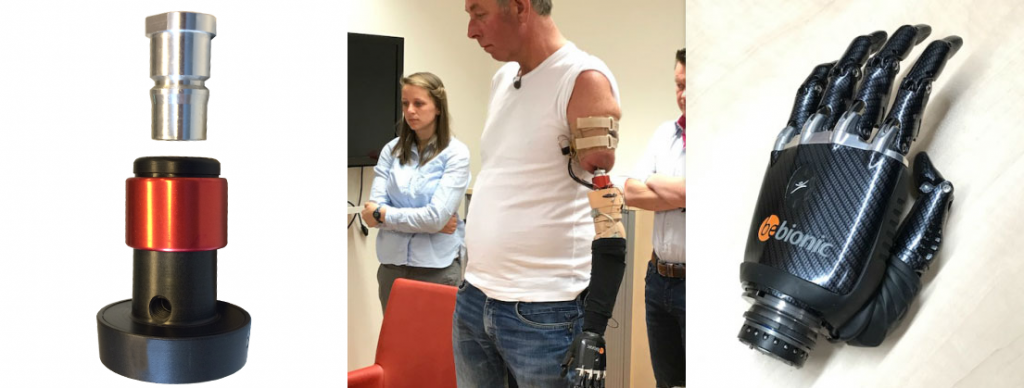Man receives first click safety robot arm.

Nijmegen
Last Friday the first dutch patient received his Click Safety robotarm. This robot arm is being click connected to the bone with a novel technologie. Unique is that the new prosthesis can be mind controlled. Worldwide only a select group of patients has such prostheses.
In April 2010 Johan Baggerman lost his arm during a severe accident. Seven years later he is one of the first patients in the world with a Click Safety Robot arm. With a Click Safety Robot arm is the arm directly connected to arm stump. The patient clicks his prosthesis onto a metal implant protruding trough an opening in the skin. Trough this direct connection between the prosthetic and skeleton a socket prosthesis becomes redundant. This novel invention prevents the prostheses from slipping down, it prevents skin problems and putting on and off becomes very easy.
Previously this method was already applied for the legs and has now been applied for the first time in The Netherlands for an arm. The largest difference with leg prosthesis at this moment is that the latest arm prosthesis communicate with the nerves of the patients trough which the arm can be mind controlled.
Freedom of motion
Chirurg Jan Paul Frölke en rehabilitation doctor Henk van de Meent and former CEO and Certified Prosthetist Harry Jansen introduced the Click Safety Adapter in The Netherlands. Since 2009 they apply this technology to patients with a leg amputation. From now on it is also possible for patients with an arm amputation to get a Click Safety Adapter. Henk van de Meent: “All movements can be made with the shoulder. Patients regain a lot of their freedom of motion. Because this is a very novel innovation, the prosthesis is not yet available on a lager scale and no agreements have been made with the reimbursement bodies yet. Per patient will be reviewed if he or she is eligible.
Surgery
For the Click Safety Arm Prosthesis three surgeries are required. During the first surgery a surgeon wil place a titanium implant into the remaining bone cavity . The outer surface of the implant as a rough surface. This rough surface is being accepted by the existing bone which grows and anchors into the surface layer of the implant, a process know as osseointegration. Six to Eight weeks later a second, short, procedure takes place. The surgeon perforates a small hole into the skin and fixated an endo exo dual cone onto the implant. This dual cone protrudes trough the skin in a way that the prosthesis can be connected. The third surgery is the so called Targeted Muscle Reinnervation (TMR) surgery by a specialized surgeon. The nerves that controlled the arm and hand before the amputation are carefully and accurately sutured to onto the remaining arm muscles of the stump. Trough this fixation the muscle functions as an amplifier of the nerve signal.
Muscle control with thoughts
After the surgery there follows a rehabilitation period where the patient will learn how to control his thoughts to control the muscles in the arm stump. When the patient opens his hand in his mind, the muscles in the arm stump contracts. This muscle activity is being measured by electrodes who embrace the arm stump like a bracelet: called the Myoband. As soon as the nerves are sufficiently grown into the muscle, the signal becomes strong enough for the sensor in the Myoband to register which allows the computer of the robot arm to start motion via Bluetooth
The rehabilitation period after the TMR is very intensive for the patient. Every day the have to mentally train their practice hand. So that when the moment is there to connect the real robot arm, the training will become much more easy because the thought of movement of the hand will directly be executed by the robot arm. The intuitive connection between brain and robot arm gives the patient the feeling of control as is he has regained his arm. After the first connection of the arm an intensive rehabilitation process follows in which the patient needs to get used to his new arm.

